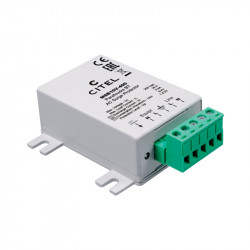Трябва да сте влезли в
Защита от пренапрежение
Категории
- Защита от пренапрежение за коаксиални приложения
- Защита от пренапрежение за системи за видеонаблюдение
- Защита от пренапрежение за захранващи кабели
- Ограничители за пренапрежение за LED
- Ограничители за пренапрежение за фотоволтаици
- Защита на системата за претегляне
- Защита от пренапрежение за Fieldbus
We’re offering a wide assortment of surge arresters for various applications: for protection in photovoltaics, for vision systems, for protecting power supply lines, for Fieldbus, for protecting LED, for RF and scale systems. Our clients can be sure they can rely on us and the quality of our products. We’re continuously trying to make the purchase process from the semiconductors’ category easy and fast.
What is power surge protection?
Power surge protection is a device, which goal is to protect electrical devices from surges. This device limits follow current. Surges are created during lightning strikes in power electronic lines or in case of turning off the aerial line. Surges can lead to damages of insulation and other elements.
What are the most important parameters of surge protection?
- Limp surge current – is a current with a shape of 10/350 µs, defined through top value and Q load. Used for testing surge arresters type 1, corresponding with the lightning current.
- AC In current – is a current with a shape of 8/20 µs. Used testing surge arresters type 1 and 2, corresponding with the lightning current or commutation surges.
- The Highest discharge current Imax – is a max value of a current with a shape of 8/20 µs, which will not damage the arrester type 2.
- The Highest voltage of stable work Uc – AC value which can be permanently led to clamps of surge arresters.
- Voltage protection level Up – is a parameter characterized by work of surge arrester, describing the biggest voltage value to which the surge is limited.
- Odd surge UT– is the biggest surge value, which, if working for a given period of time, will not damage the arrester.
- Max security – the highest value of security montaged before the arrester to protect from long-time short circuit currents.
Types and applications of surge arresters.
We distinguish the following types of surge arresters:
- Type 1 – protects from direct and close lightning strikes.
- Type 2 – protects the majority of receivers from commutation surges and reduced surges by surge arresters type 1.
- Type 3 – protects especially sensitive/expensive electrical and electronic devices.
- Sets of surge arresters type 1+2.
Surge arresters type 1 are mostly installed at the beginning of the installation, powered from cable system or aerial system e.g. main switchgear nn. Their task is to carry lightning current, created during direct lightning strikes.
Surge arrester hybrid type 1+2 are installed before the meter, protecting it from possible surges. This type of devices provide protection from lightning strikes into objects close to arterial lines, directly to the line or in some distance from the surge arrester installation place.
Surge arresters type 2 protect installation from potential causes of surges, created due to lightning strikes or connection processes in power electronic systems. Their task is to limit surges caused by protection apparatus. Used to protect engines, transformers and welders.
Type 3 used for protecting audiovisual devices and computers. Their task is to protect sensitive receivers from surges, which were reduced at previous protection levels. These devices are used in case of unspecified resistance of current apparatus or when the distance between the sensitive device and last protection level, equals several dozens of meters.






















